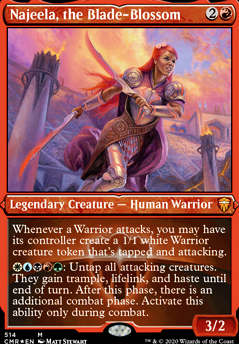
Warrior Queen [Najeela Midrange/Tempo cEDH Primer]
Commander / EDH Competitive Five Color Infinite Combo Midrange
Instant (31)
-
1x
Abrupt Decay

-
1x
Ad Nauseam

-
1x
Assassin's Trophy

-
1x
Brainstorm

-
1x
Cyclonic Rift

- 1x Deflecting Swat
-
1x
Delay

- 1x Demonic Consultation
-
1x
Dispel

-
1x
Dovin's Veto

-
1x
Drown in the Loch

-
1x
Eladamri's Call

-
1x
Enlightened Tutor

- 1x Fierce Guardianship
- 1x Fire Covenant
-
1x
Flusterstorm

-
1x
Force of Will

- 1x Lim-Dul's Vault
-
1x
Mana Drain

-
1x
Mental Misstep

-
1x
Mystical Tutor

-
1x
Noxious Revival

-
1x
Pact of Negation

-
1x
Plunge into Darkness

-
1x
Pyroblast

- 1x Red Elemental Blast
-
1x
Silence

-
1x
Swan Song

-
1x
Tainted Pact

-
1x
Vampiric Tutor

-
1x
Veil of Summer

Sorcery (7)
Land (30)
-
1x
Arid Mesa

- 1x Badlands
- 1x Bayou
-
1x
Bloodstained Mire

-
1x
Breeding Pool

-
1x
City of Brass

-
1x
Command Tower

-
1x
Exotic Orchard

-
1x
Flooded Strand

-
1x
Forbidden Orchard

-
1x
Hallowed Fountain

-
1x
Mana Confluence

-
1x
Marsh Flats

-
1x
Misty Rainforest

-
1x
Overgrown Tomb

-
1x
Polluted Delta

- 1x Savannah
-
1x
Scalding Tarn

- 1x Scrubland
- 1x Taiga
-
1x
Tarnished Citadel

- 1x Tropical Island
- 1x Tundra
- 1x Underground Sea
-
1x
Verdant Catacombs

- 1x Volcanic Island
-
1x
Waterlogged Grove

-
1x
Watery Grave

-
1x
Windswept Heath

-
1x
Wooded Foothills

Artifact (5)
Commander (1)
Creature (18)
-
1x
Arbor Elf

-
1x
Avacyn's Pilgrim

-
1x
Aven Mindcensor

-
1x
Birds of Paradise

-
1x
Dark Confidant

-
1x
Deathrite Shaman

-
1x
Derevi, Empyrial Tactician

- 1x Dockside Extortionist
-
1x
Drannith Magistrate

-
1x
Elves of Deep Shadow

-
1x
Elvish Mystic

- 1x Gilded Drake
-
1x
Llanowar Elves

-
1x
Mindblade Render

-
1x
Noble Hierarch

-
1x
Oakhame Adversary

- 1x Thassa's Oracle
-
1x
Vexing Shusher

Enchantment (8)
Sideboard
Maybeboard
Instant (10)
Creature (6)
- 1x Collector Ouphe
- 1x Containment Priest
-
1x
Fyndhorn Elves

- 1x Linvala, Keeper of Silence
- 1x Notion Thief
-
1x
Tymna the Weaver
 *f-etch*
*f-etch*
Sorcery (2)
Enchantment (3)
Artifact (3)
Land (1)
Suggestions
Updates Add
Comments View Archive
Attention! Complete Comment Tutorial! This annoying message will go away once you do!
Important! Formatting tips — Comment Tutorial — markdown syntax
Please login to comment
Revision 33 See all
(5 years ago)
| +1 | Ad Nauseam | main |
| +1 | Deflecting Swat | main |
| +1 | Drannith Magistrate | main |
| +1 | Fierce Guardianship | main |
| +1 | Lotus Petal | main |
| +1 | Notion Thief | maybe |
| Top Ranked |
|
| Date added | 6 years |
| Last updated | 4 years |
| Legality | This deck is not Commander / EDH legal. |
| Rarity (main - side) | 27 - 0 Mythic Rares 45 - 2 Rares 12 - 0 Uncommons 16 - 2 Commons |
| Cards | 100 |
| Avg. CMC | 1.67 |
| Tokens | Bird 2/2 U, Spirit 1/1 C, Treasure, Warrior 1/1 W |
| Folders | Primers, 5 color, cEDH Ideas, Cool decks, Commander, Competitive edh, Deck Ideas, Interesting Decks to Study Better Later, Online decks, Idea List |
| Votes | |
| Ignored suggestions | |
| Shared with | |
| Views |














